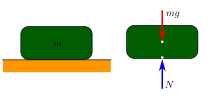Our website is made possible by displaying online advertisements to our visitors.
Please consider supporting us by disabling your ad blocker.
Mechanical equilibrium

In classical mechanics, a particle is in mechanical equilibrium if the net force on that particle is zero.[1]: 39 By extension, a physical system made up of many parts is in mechanical equilibrium if the net force on each of its individual parts is zero.[1]: 45–46 [2]
In addition to defining mechanical equilibrium in terms of force, there are many alternative definitions for mechanical equilibrium which are all mathematically equivalent.
- In terms of momentum, a system is in equilibrium if the momentum of its parts is all constant.
- In terms of velocity, the system is in equilibrium if velocity is constant. * In a rotational mechanical equilibrium the angular momentum of the object is conserved and the net torque is zero.[2]
More generally in conservative systems, equilibrium is established at a point in configuration space where the gradient of the potential energy with respect to the generalized coordinates is zero.
If a particle in equilibrium has zero velocity, that particle is in static equilibrium.[3][4] Since all particles in equilibrium have constant velocity, it is always possible to find an inertial reference frame in which the particle is stationary with respect to the frame.
- ^ a b John L Synge & Byron A Griffith (1949). Principles of Mechanics (2nd ed.). McGraw-Hill.
- ^ a b Beer FP, Johnston ER, Mazurek DF, Cornell PJ, and Eisenberg, ER (2009). Vector Mechanics for Engineers: Statics and Dynamics (9th ed.). McGraw-Hill. p. 158.
{{cite book}}: CS1 maint: multiple names: authors list (link) - ^ Herbert Charles Corben & Philip Stehle (1994). Classical Mechanics (Reprint of 1960 second ed.). Courier Dover Publications. p. 113. ISBN 0-486-68063-0.
- ^ Lakshmana C. Rao; J. Lakshminarasimhan; Raju Sethuraman; Srinivasan M. Sivakumar (2004). Engineering Mechanics. PHI Learning Pvt. Ltd. p. 6. ISBN 81-203-2189-8.
Previous Page Next Page


